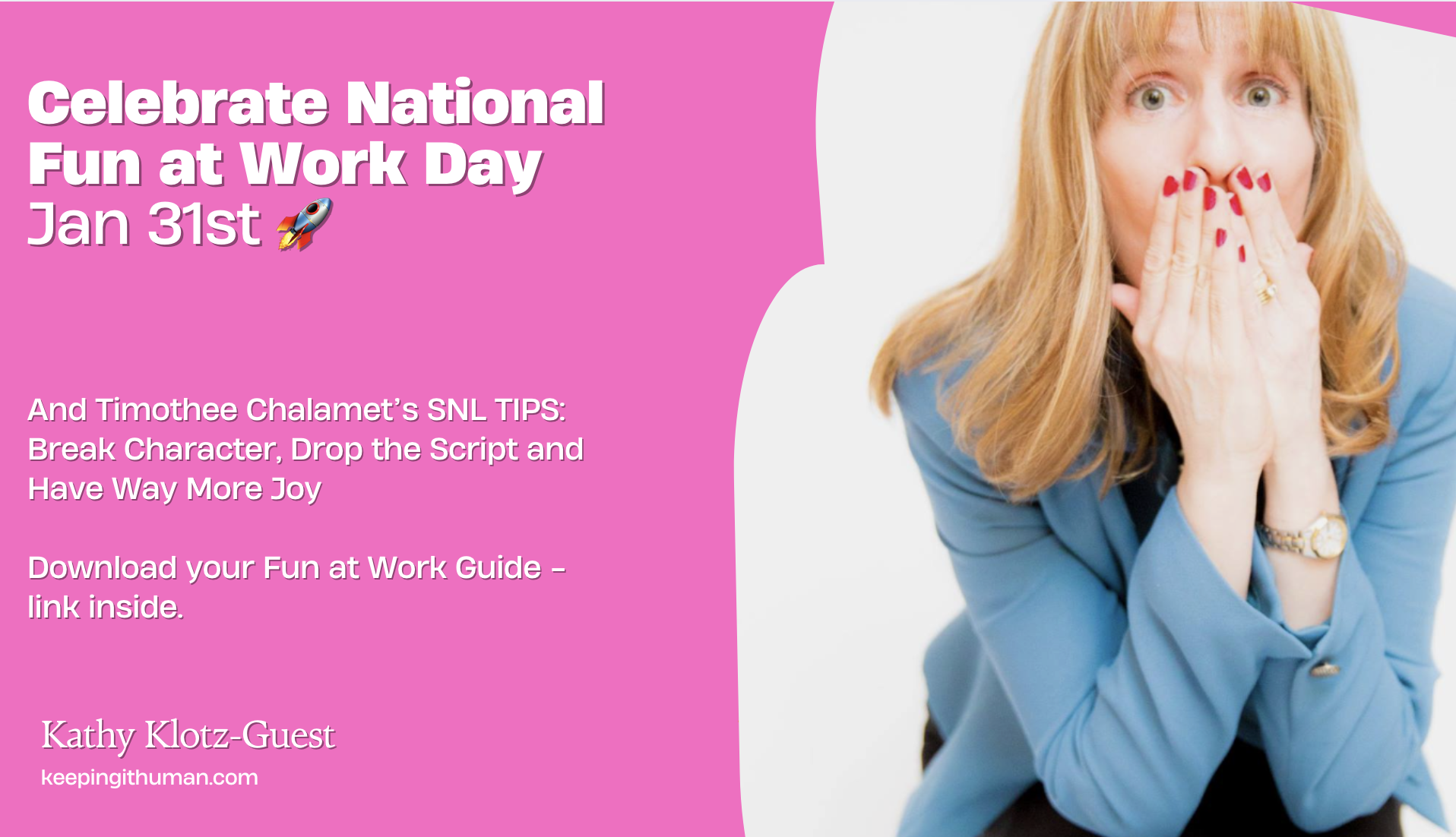I have written about the role of humor in sales and marketing many times. To read some of those articles, visit:
http://kathyklotzguest.wordpress.com/2011/
https://www.keepingithuman.com/blog/
http://www.powerfullyfunny.com/powerfully-funny-resources.html
After a recent panel discussion at an event where I was asked this question, I am revisiting it. The challenge: giving a short answer on a nuanced issue.
The short answer is an unequivocal “yes” with a few obligatory, boring and important notes. The lens I frame my answer through is as a marketing strategist first and foremost, and as an experienced comic improviser and sketch comedian, second. That means as much as I love using humor when it works (hey, it’s as human as you can get!), it’s important to remember that, in business, humor must serve the marketing goal – not the other way around.
First, levity, fun, and humor are great at driving awareness. They are great pattern disruption devices and in a world of too much noise, you need to get attention before you can sell. Think about the last funny headline you saw. You clicked on that, didn’t you? Humor stands out – especially when it creates the critical element of surprise. Surprise is an important pattern disruption device because it deviates from the expected. The unexpected makes us take notice. In a world of boring, sometimes insultingly self-absorbed marketing approaches, levity is a fabulous thing!
Second, humor creates a human connection. Without a human connection, you can’t move your audience to a place where they actually care. Both awareness and connection are critical components to moving your audience to buy. Humor is a fantastic conversation starter.
Yet, the dynamics and critical success factors of b2b selling are different from those in consumer markets. Humorous copy alone isn’t likely to drive sales in b2b. Yes, humor will grab attention and create a needed connection with your audience. Think about how IBM was able to upend expectations with their seminal video parodies, “The Art of the Sale.” The b2b sales cycle, however, is longer, more complex, and has more risk associated with purchasing than with consumer purchases. Organizations still need a compelling reason to buy, no matter how great the humor is.
Still, b2b doesn’t mean blah to boring, and humor can grab attention in b2b precisely because it’s simple, human and unexpected. Business is always about people. And nothing is more anti-human than robotic-sounding messaging with mind-numbing garbage that will drain IQ points faster than Liquid Plumbr™ attacks clogs: “Game-changing, disruptive, solutions, revolutionary, proprietary, methodology, blah, blah, blah.” Shoot me now. Please.
Can’t Get to Funny Without Fun (Seriously. Try Spelling It.)
Funny is also not the same thing as fun in my experience. This is an important and misunderstood point in a lot of the pop-culture advice I see out there. You don’t need laugh-out-loud approaches to work; what matters is making your audience smile. Humor is great; yet not necessary to connect at that human level with your audience. Simply having fun, a little levity, and demonstrating a personality (not explicit humor per se) can work wonders. So if funny seems daunting; start with having a little fun and showing a little personality.
When my Firefox browser crashes, for example, I get a “Well, that’s embarrassing,” message. Not a knee-slapper; yet it makes me smile and so I remember it. With that act, you have made a positive human connection – which is the most important goal of marketing regardless of what kind of marketing you are doing. People want a human connection. They also want a real benefit and reason to buy –and you still need to deliver the goods with great products and the right messaging. Without it, funny won’t make you money. Remember, human needs are often psychological, so you have to appeal to their emotions, not just their heads. As Dan Ariely, author of Predictably Irrational rightly explains, people (even in business!) rarely make rational choices because people aren’t robots.
So You Got My Attention…Now What?!
Once you grab attention, you need to connect on an emotional level by tying your company, service, offering (whatever) to a real need – a real human challenge that your prospect has. You still have to give your audience the “why.” If you can’t connect your message to a reason for your audience to buy your product, than all the levity in the world – especially with higher-risk products –won’t inspire customers to take action. And no amount of humor, levity, fun, or personality – no matter how great it is – will ever compensate for your product’s inability to address a human need (see my Nov 17th blog post ).
It’s your “why” that bridges the gap between grabbing attention and motivating sales behavior. People don’t exist to buy business services. Services exist to serve real human needs, so unless, you can demonstrate a real connection to a challenge your customer faces, no amount of “personality” will be relevant enough to inspire customer action. To get people to act, you need to get them to feel a strong personal connection so that they believe your services are what they need.
So here’s a revised equation that’s better for b2b sales:
Humor + connecting to an urgent human need (the why)
This brings us to another key point: intent matters. What do you intend to happen with your copy? The “Think, Feel, Do” mantra of marketing means you need to be clear in what you want users to do after reading your copy. Do you want them to visit your site or to request information? If your intent is to drive sales, you have to be relevant and connect at the human need level. Without a need, humor is a nice diversion, but only that. If your goal is create awareness and leave your audience with a certain feeling about your company or products by changing expectations rather than trying to drive sales per se, then humor is a great way to advance that goal.
Humor – Like A Lot of Things in Marketing – is A Lot of Art
This is one of the most important points of all: There is no formula for humor. Sure, marketing is part science; and it’s a whole lot of art. In fact – in my experience, it’s mostly art. And humor is where art comes in.
I am asked many times for my formula: there isn’t one because every situation, every client, and audience need is different. All of those need to be taken into account. In the consumer world, the Old Spice campaign really changed the way markers thought about what parody could be. However, it also created a bit of a “me too” mentality. Marketers set about trying to reverse engineer the elements of that model in hopes that they, too, could crack the viral marketing code.
Forget viral and forget templates. The issue is once that template is written – it’s no longer new to the world. That template is owned by Old Spice. The best thing any organization can do is throw away anything derivative and create a new template.
That means taking a creative risk. That’s exactly the role of art; it’s the role of science to take the risk out of the equation by making outputs predictable and replicable. Marketers must take creative risks to see what works. Low risk, low reward, right? And if marketers wanted to play it “safe,” we wouldn’t be doing our jobs.
In the next post, we’ll look at examples of humor in b2b that work!
Let me know what you think!


